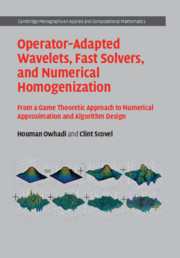 Operator-Adapted Wavelets, Fast Solvers, and Numerical Homogenization
Operator-Adapted Wavelets, Fast Solvers, and Numerical Homogenization Book contents
- Frontmatter
- Dedication
- Contents
- Preface
- Acknowledgements
- Reading Guide
- 1 Introduction
- Part I The Sobolev Space Setting
- Part II The Game Theoretic Approach
- Part III The Banach Space Setting
- Part IV Game Theoretic Approach on Banach Spaces
- Part V Applications, Developments, and Open Problems
- 21 Positive Definite Matrices
- 22 Nonsymmetric Operators
- 23 Time-Dependent Operators
- 24 Dense Kernel Matrices
- Part VI Appendix
- Bibliography
- Algorithms
- Glossary
- Nomenclature
- Index
- Identities
23 - Time-Dependent Operators
from Part V - Applications, Developments, and Open Problems
Published online by Cambridge University Press: 10 October 2019
- Frontmatter
- Dedication
- Contents
- Preface
- Acknowledgements
- Reading Guide
- 1 Introduction
- Part I The Sobolev Space Setting
- Part II The Game Theoretic Approach
- Part III The Banach Space Setting
- Part IV Game Theoretic Approach on Banach Spaces
- Part V Applications, Developments, and Open Problems
- 21 Positive Definite Matrices
- 22 Nonsymmetric Operators
- 23 Time-Dependent Operators
- 24 Dense Kernel Matrices
- Part VI Appendix
- Bibliography
- Algorithms
- Glossary
- Nomenclature
- Index
- Identities
Summary
This chapter reviews the application of gamblets to the opening of the complexity bottleneck of implicit schemes for hyperbolic and parabolic ODEs/PDEs with rough coefficients. In this setting, the spatial component of the PDE is an elliptic operator on a Sobolev space, and since the natural truncationof the gamblet decomposition of the operator is rank-revealing, in that it is adapted to the eigensubspaces of the operator, these gamblet decompositionscan be naturally applied to the simulation of time-dependent operators. These gamblets are not only adapted to the coefficients of the underlying PDE but also to the numerical scheme used forits time discretization. For higher order PDEs these gamblets may be complex-valued.
Keywords
- Type
- Chapter
- Information
- Operator-Adapted Wavelets, Fast Solvers, and Numerical HomogenizationFrom a Game Theoretic Approach to Numerical Approximation and Algorithm Design, pp. 410 - 420Publisher: Cambridge University PressPrint publication year: 2019
